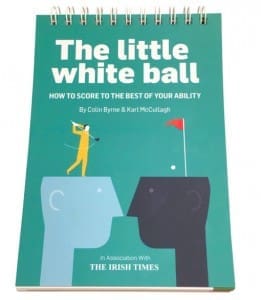Golf in the Mind
Colin Byrne
Colin is one of the golfing world’s leading caddies and has spent the last 30 years travelling the globe working with some of the best international players. He is currently caddying for Ernie Els and when he is not caddying his excellent journalistic talents can be seen in The Irish Times. Over many years Colin has written hundreds of articles helping readers to get an insight into the USPGA and The European Tour. He has also written two books Bagman 1 and Bagman 2 both of which were very successful. When he is not away working Colin plays most of his golf in Royal Dublin Golf Club off a very respectable 6 handicap.
You are never quite sure when you have an idea how it is actually going to turn out when you start to write something or if you will ever get it finished. It’s a little bit like heading off to a country you have never been to before and not knowing what lies ahead of you.
So when my golfing buddy Karl suggested that us amateurs needed some help with our strategy on the golf course we agreed that it might be worth a trip to that ‘foreign land’. We had an idea to create a pocket sized strategy book to use while you are actually playing the game as this had not really been done before. This is not dissimilar to the notes that professional players carry with them for all tournaments.
As an international caddie to professional golfers for over three decades I have witnessed golf at the highest level played under the most intense competitive pressure. I have figured out what it is that has to be done to bring a score back to the clubhouse when you are not really up to it or when you are feeling the disorienting effects of pressure.
Of course these top golfers are highly talented and hit thousands of balls a week but they still need the strategic and mental discipline to ‘get it done’ over the four rounds of a tournament.
The one aspect of their rounds that is almost boringly repetitive is how they stick rigidly to a process and routine which is why they attain such high levels of consistent performance. So our goal with “The little white ball” is to introduce this idea of process and routine to amateur golfers of all ages and ability and let them see where this discipline could take them.
As an amateur golfer but a professional caddie I understand that you don’t always feel like applying yourself on the course. As amateurs we have that option to just cruise and see what the round may bring. The professionals do not have such casual luxury, they have to make it happen or run the risk of extinction.
The important thing for us casual players to remember is to keep going with whatever attitude you have decided to use from the outset. In other words if you find yourself under par with a nonchalant approach don’t change your casual routine. Likewise if you adopt the more focused attitude try to keep it going throughout the round.
As an international caddie to professional golfers for over three decades I have witnessed golf at the highest level played under the most intense competitive pressure. I have figured out what it is that has to be done to bring a score back to the clubhouse when you are not really up to it or when you are feeling the disorienting effects of pressure.
Of course these top golfers are highly talented and hit thousands of balls a week but they still need the strategic and mental discipline to ‘get it done’ over the four rounds of a tournament.
The one aspect of their rounds that is almost boringly repetitive is how they stick rigidly to a process and routine which is why they attain such high levels of consistent performance. So our goal with “The little white ball” is to introduce this idea of process and routine to amateur golfers of all ages and ability and let them see where this discipline could take them.
Myself and Karl finished second and third in the club competition we played in the week after we finished writing the ‘The Little White Ball’. We both attempted to apply the principles of ‘process and routine’ in our rounds and found ourselves in winning positions.
Mental discipline is not the easiest thing to achieve in your golf but it has a very positive effect. So if you have a look at our attempt to bring a professional mind-set to your amateur game I would be very surprised if it was not way more valuable to you than the latest driver you spent a fortune on. What we have put together is a very simple message that can be used by everyone. The key benefit is that you will start to avoid making the stupid mistakes that ruin a good card.
If you want to realise your true potential as a golfer adopt a Process and Routine and enjoy the positive results that will follow.
“The little white ball” is available in golf shops and Easons countrywide and online at www.golfinthemind.com.
Our goal is to share the knowledge that Colin has gained working as one of the world’s top caddies. Colin has seen the best players in the world win the biggest tournaments and also worked with superb players who at crucial times made the wrong decisions like the rest of us. We want to give golfers of all ages and ability a clear,simple Process and Routine each time they go out to play. It takes a little effort and may not be something for every round but in time it will become second nature and happen anyway. The end result will be better scoring, increased confidence and greater enjoyment of the game of golf.



